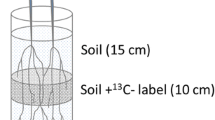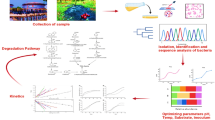Abstract
Phenanthrene and methyl-phenanthrenes are major aromatic pollutants originating in particular from fuel oil. Phenanthrene is usually degraded faster than methyl-phenanthrenes under geological and environmental conditions. Here, we report a preferential and accelerated biodegradation of methyl-phenanthrenes versus phenanthrene in soil contaminated by fuel oil. The polluted soil was mixed with sawdust and sand to form a homogenized biopile. The biopile was continuously sprayed with microbial consortia isolated from crude oil–contaminated soil and treated by biosurfactants and nutritive substances for biostimulation. During a 6-month bioremediation experiment, a steady increase in the relative abundance of phenanthrene compared to methyl-phenathrenes was observed by gas chromatography–mass spectrometry. The increase was the highest for trimethyl-phenanthrenes, with a phenanthrene/trimethyl-phenanthrenes ratio increasing from 0.42 to 2.45. By contrast, the control, non-stimulated samples showed a ratio decrease from 0.85 to 0.11. Moreover, the results showed that the level of degradability depends on the number of methyl groups.




Similar content being viewed by others
References
Alexander M (1994) Biodegradation and bioremediation. Academic Press, San Diego
Antić M, Jovančićević B, Ilić M, Vrvić MM, Schwarzbauer J (2006) Petroleum pollutant degradation by surface water microorganisms. Environ Sci Pollut Res 13:320–327
Atagana HI, Haynes RJ, Wallis FM (2003) Optimization of soil physical and chemical conditions for the bioremediation of creosote-contaminated soil. Biodegradation 14:297–307
Bamfort SM, Singleton I (2005) Bioremediation of polycyclic aromatic hydrocarbons: current knowledge and future directions. J Chem Technol Biotechnol 80:723–736
Beškoski V, Gojgić-Cvijović G, Milić J, Ilić M, Miletić S, Čolević T, Vrvić MM (2011) Ex situ bioremediation of a soil contaminated by mazut (heavy residual fuel oil)—a field experiment. Chemosphere 83:34–40
Bossert I, Bartha R (1984) The fate of petroleum in the soil ecosystems. In: Atlas RM (ed) Petroleum microbiology. Macmillan, New York, NY, pp 435–473
Bryselbout C, Henner P, Carsignol J, Lichtfouse E (2000) Polycyclic aromatic hydrocarbons in highway plants and soils. Evidence for a local distillation effect. Analusis 28:290–293
Cerniglia CE (1992) Biodegradation of polycyclic aromatic hydrocarbons. Biodegradation 3:351–368
Cerniglia CE, Yang SK (1984) Stereoselective metabolism of anthracene and phenanthrene by the fungus Cunninghamella elegans. Appl Environ Microbiol 47:119–124
Davies JI, Evans WC (1964) Oxidative metabolism of naphthalene by soil pseudomonads: the ring fission mechanisms. J Biochem 91:251–261
Ferguson JF, Pietari JMH (2000) Anaerobic transformations and bioremediation of chlorinated solvents. Environ Pollut 107:209–215
Fritsche W, Hofrichter M (2008) Biotechnology. Wiley, New York, NY
Gavrilescu M (2005) Eng Life Sci 5:497–526
Henner P, Schiavon M, Morel J-L, Lichtfouse E (1997) Polycyclic aromatic hydrocarbons (PAH) occurrence and remediation methods. Analusis 25:M56–M59
Henner P, Schiavon M, Druelle V, Lichtfouse E (1999) Phytotoxicity of ancient gaswork soils. Effect of polycyclic aromatic hydrocarbons (PAHs) on plant germination. Org Geochem 30:963–969
Huang H, Larter SR, Bowler BFJ, Oldenburg TBP (2004) A dynamic biodegradation model suggested by petroleum compositional gradients within reservoir columns from the Liaohe basin, NE China. Org Geochem 35:299–316
Ilić M, Antić M, Antić V, Schwarzbauer J, Vrvić MM, Jovančićević B (2011) Investigation of bioremediation potential of zymogenous bacteria and fungi for crude oil degradation. Environ Chem Lett 9:133–140
Jovančićević B, Polić P, Vrvić MM, Sheeder G, Teschner T, Wehner H (2003) Transformations of n-alkanes from petroleum pollutants in alluvial ground waters. Environ Chem Lett 1:73–81
Jovančićević B, Antić M, Šolević T, Vrvić M, Kronimus A, Schwarzbauer J (2005) Investigation of interactions between surface water and petroleum type pollutant. Environ Sci Pollut Res 12:205–212
Lamberts RF, Christensen JH, Mayer P, Andersen O, Johnesen AR (2008) Isomer-specific biodegradation of methylphenanthrenes by soil bacteria. Environ Sci Technol 42:4790–4796
Lichtfouse E, Albrecht P, Behar F, Hayws JM (1994) A molecular and isotopic study of the organic matter from the Paris Basin, France. Geochim Cosmochim Acta 58:209–221
Lichtfouse E, Sappin-Didier V, Denaix L, Caria G, Metzger L, Amellal-Nassr N, Schmidt JA (2005) 25-year record of polycyclic aromatic hydrocarbons in soils amended with sewage sludges. Environ Chem Lett 3:140–144
Nousiainen U, Torronen R, Hanninen O (1984) Differential induction of various carboxylesterases by certain polycyclic aromatic hydrocarbons in the rat. Toxicology 32:243–251
Peters KE, Walters JM, Moldowan JM (2005) The biomarker guide: biomarkers and isotopes in the petroleum exploration and earth history, vol 2. Cambridge University Press, Cambridge
Simmon VF, Rosenkranz HS, Zeiger E, Poirier LA (1979) Mutagenic activity of chemical carcinogens and related compounds in the intraperitoneal host-mediated assay. J Natl Cancer Inst 62:911–918
Singh A, Ward OP (2004) Biodegradation and bioremediation. Springer, Berlin
Šolević T, Novaković M, Ilić M, Antić M, Vrvić MM, Jovančićević B (2011) Investigation of the bioremediation potential of the soil aerobic zymogenous microorganisms in crude oil biodegradation. J Serb Chem Soc 76:425–438
Stojanović K, Jovančićević B, Vitorović D, Pevneva G, Golovko J, Golovko A (2007) New maturation parameters based on naphthalene and phenanthrene isomerization and dealkylation processes aimed at improved classification of crude oils (Southeastern Pannonian Basin, Serbia). Geochem Int 45:781–797
Van Hamme JD, Singh A, Ward OP (2003) Microbiol Mol Biol Rev 67:503–549
Volkman JK, Alexander R, Kagi RI, Woodhouse GW (1983) Demethylated hopanes in crude oils and their applications in petroleum geochemistry. Geochim Comochim Acta 47:785–794
Acknowledgments
We thank the Ministry of Education and Science of the Republic of Serbia (Projects 176006 & III 43004) for supporting this research.
Author information
Authors and Affiliations
Corresponding author
Electronic supplementary material
Below is the link to the electronic supplementary material.
Rights and permissions
About this article
Cite this article
Novaković, M., Ramadan, M.M.A., Knudsen, T.Š. et al. Degradation of methyl-phenanthrene isomers during bioremediation of soil contaminated by residual fuel oil. Environ Chem Lett 10, 287–294 (2012). https://doi.org/10.1007/s10311-012-0354-6
Received:
Accepted:
Published:
Issue Date:
DOI: https://doi.org/10.1007/s10311-012-0354-6




